This article also may be read in Arabic.
Two refrigerated shipping containers are easy to overlook in a nondescript parking lot between a CrossFit gym and a busy thoroughfare in Portland, Maine. But their contents are decidedly out of place atop the asphalt: tanks of percolating seawater, within which leafy green and brown seaweed, or macroalgae, appear to dance as bubbles churn the water.
The containers belong to a company called Running Tide, and its Portland facility offers “macroalgae on tap,” said Nate Beatty, Running Tide’s vice president of scientific technology. The company needs a plentiful supply because its employees are currently testing ways to send tons of seaweed to the bottom of the ocean.
Running Tide is one of many organizations asking whether submerging seaweed could be part of an effective strategy for mitigating climate change. When these algae photosynthesize, they turn carbon dioxide from the upper ocean into biomass. In some parts of the ocean, submerging that biomass below thousands of meters of water could lock its carbon away for hundreds or even thousands of years, drawing down levels of carbon in the atmosphere.
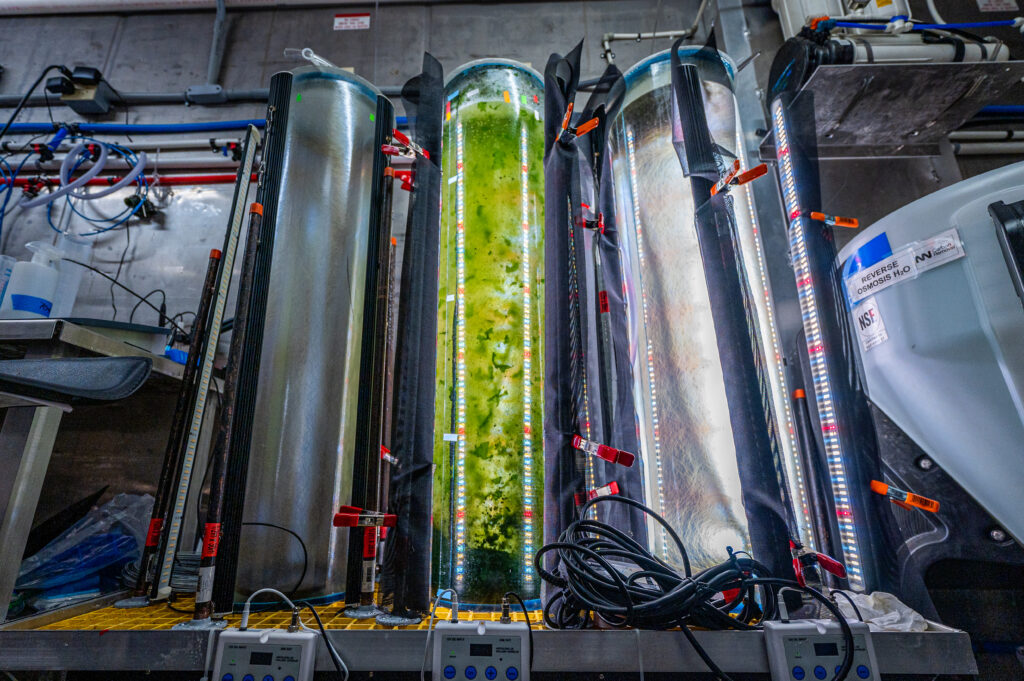
Because oceans cover more than 70% of the planet, there’s a lot of space available to grow and sink seaweed. If companies can sell credits for around $100 per ton of carbon that they sink—the point at which many experts say carbon credits become economically viable—the market could come to hundreds of billions of dollars, if not a trillion, per year. For many scientists and entrepreneurs, the approach holds tantalizing potential.
“We desperately need a science-first approach.”
But major questions remain. For example, if growing seaweed depletes the pool of nutrients available for other forms of ocean life, then will it actually increase the ocean’s net carbon storage? What happens to ocean bottom ecosystems if humanity creates giant, underwater seaweed landfills? And how will companies monitor the effects of sending tons of seaweed to a watery grave?
“We desperately need a science-first approach,” said marine scientist David Siegel from the University of California, Santa Barbara. With climate change posing imminent threats, however, some people think delaying action to wait for more research is dangerous. Some companies are forging on.
Monstrous Growth Rates
The ecological allure of macroalgae lies in its growth rate. Under ideal conditions, one species of seaweed, giant kelp, can elongate by more than half a meter (2 feet) per day. “It feels like you can almost sit there and watch it [grow],” said physical coastal oceanographer Kristen Davis from the University of California, Irvine. And the nutritional cost is low: Giant kelp, for example, takes up around 20 or 30 atoms of carbon for every atom of nitrogen it needs to grow. (Microscopic phytoplankton, on the other hand, incorporate only about seven carbon atoms for every nitrogen atom.)
Three types of seaweed have garnered the most attention: sugar kelp and giant kelp—both coastal macroalgae that grow upward from the ocean bottom—and Sargassum, a clumpy, tangled seaweed that floats freely in the open ocean.
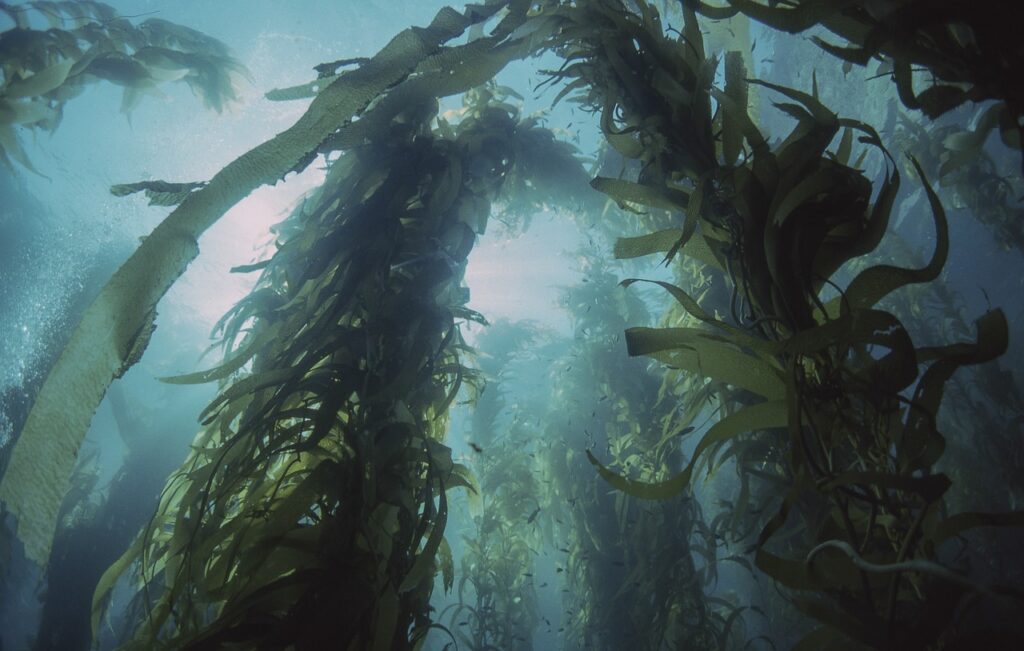
Making a significant dent in atmospheric carbon will require growing a lot of kelp or Sargassum. A belt of kelp 100 meters wide running along 63% of the world’s coastlines would be needed to produce 0.1 gigaton of seaweed carbon per year—1% of what needs to be sequestered by midcentury to keep global warming below 2°C—according to a committee convened by the National Academies of Sciences, Engineering, and Medicine. For Sargassum grown in the open ocean, a farm half the size of Iowa would have a similar impact.
“It’s preposterous,” Siegel said of the scale needed. Siegel was a member of the National Academies committee.
Only certain parts of the ocean have the nutrients needed to support robust seaweed growth, a recent study reported. To help seaweed thrive outside these regions, some scientists have suggested pulling nutrient-rich water up from the depths of the ocean—a process called artificial upwelling. But this technology has never been tested at the scope necessary for large-scale seaweed farming.
Seaweed also has a poorly understood way of releasing hundreds of carbon-containing dissolved organic molecules into the water around it, often as mucus. Around 14% of the carbon incorporated into kelp may be released in this manner, although scientists are still researching the issue, and there seems to be a lot of variability, according to microbial oceanographer Craig Carlson from the University of California, Santa Barbara.
How easily microbes can chew up these organic molecules, potentially releasing their carbon back into the atmosphere, is also an open question. “It’s still early days,” Carlson said.
The ecological impacts of dropping tons of biomass to the ocean bottom are currently unclear as well. If microbes break down the seaweed, they may rob the waters of oxygen in the process, killing off other forms of life. The physical habitat would also change, potentially disrupting many animals’ homes. “Long story short is that we don’t have a good understanding of what happens,” said Kristen Davis.
A Distributed Approach
In the coming years, Running Tide plans to release billions of baseball- to basketball-sized seaweed-bearing buoys off the coast of Iceland.
Building and operating a giant, stationary seaweed farm in the open ocean comes with potentially intractable challenges. To make seaweed farming more feasible, Running Tide is going with a modular approach.
In the coming years, the company plans to release billions of baseball- to basketball-sized seaweed-bearing buoys off the coast of Iceland. The buoys will wander the ocean for weeks or months while the seaweed grows, then naturally become waterlogged and sink. Eventually, the company hopes to sink megatons or even gigatons of biomass every year.
On an afternoon last September, an array of buoy designs sat on a table near the entrance to Running Tide’s Portland location. Most looked like a hybrid of plywood and Styrofoam. In fact, they were made of compressed wood chips bound with a mixture of limestone and cement or with a fungus called mycelium.
In a lab space one room over, prototype buoys were pummeled by water churning in wave tanks. For most species of seaweed, floating for 3 months before becoming waterlogged is “kind of a sweet spot,” said Running Tide’s director of verification hardware, engineer Andrew Thompson. Any shorter, and the seaweed might not grow completely before it sinks. Longer, and there’s a risk the buoy will drift back into shallow water, where sunken carbon can more easily find its way back into the atmosphere.
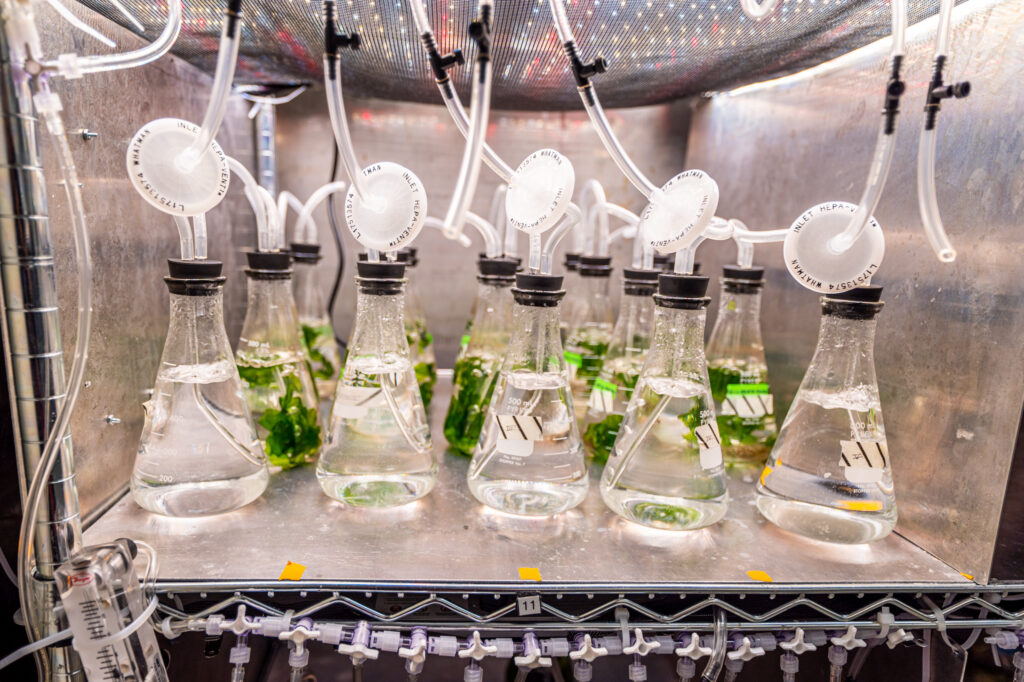
Running Tide’s engineers release buoys from a boat about 160 kilometers off the coast of Iceland and use knowledge of ocean currents to predict where they’ll end up. GPS trackers and cameras included in each deployment let them know whether their predictions pan out. A swarm released last summer hit the target area off the coast of Greenland, where the surface water is replete with nutrients and the bottom water is deep.
A distributed approach to seaweed farming avoids shading organisms that live beneath the surface and circumvents the logistical challenges of setting up a stationary farm.
But there’s a trade-off: It’s tough to keep an eye on the sunken seaweed to make sure it’s not decomposing and releasing greenhouse gases back into the atmosphere or having other negative environmental consequences. And proactively researching such impacts is critical to ensuring that the approach is actually mitigating climate change, said biogeochemical oceanographer Matthew Long from the nonprofit ocean modeling research organization [C]Worthy. “A real significant danger, if you can’t quantify the effect, is that our carbon market…is built on a false pretense,” he said.
Steven Davis, an Earth system scientist from the University of California, Irvine, concurred. Assessing the effect of sinking seaweed, he said, “is hard enough, even if you know how much seaweed you’ve harvested and sunk.” Having the seaweed drifting around will make it harder.
Thompson admitted that the distributed nature of the project “puts a lot of burden on our verification tech.”
Running Tide does keep tabs on ocean conditions in and around where its buoys sink by using floating devices and taking samples from the ship it uses to deploy the buoys.
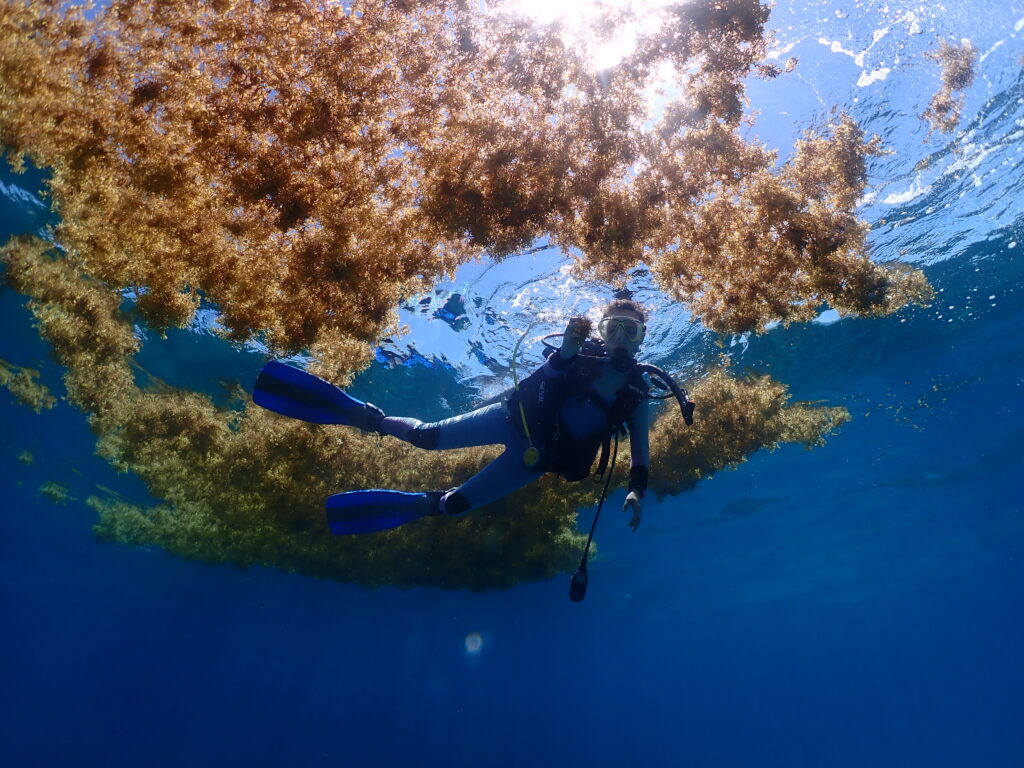
Sinking Sargassum
While Running Tide is shipping lab-grown seaweed offshore, scientists at a company called Seafields are aiming to set up shop in the open ocean. By the early 2030s, the company plans to have built a 65,000-square-kilometer farm in the South Atlantic subtropical gyre, between Brazil and Namibia. Eventually, they hope to scale the farm to 94,000 square kilometers—an area slightly larger than Portugal.
“The scalability [of Sargassum farming] is immense.”
The massive effort would use artificial upwelling to supplement the region’s naturally low nutrient levels, said marine biogeochemist Miriam Philippi from the Alfred Wegener Institute, a scientific adviser for the project. By her calculations, even an area the size of London could grow enough seaweed to sequester 10 megatons of carbon dioxide per year. “If you think about how tiny this area is compared to the middle of the ocean, the scalability is immense,” she said.
Building and maintaining such an operation will be challenging. The company envisions the offshore facility hosting hundreds of employees for shifts lasting several months. New technology will be needed to support the artificial upwelling system. The whole structure will need to weather storms and withstand currents. “It’s still a futuristic idea to maintain these infrastructures,” Philippi said.
It could be tough to monitor the impact of such a large farm, Long said. But at least its location will be fixed. “I find that a lot more compelling than…just letting everything wander around the ocean and sink when it feels like it,” said biogeochemist Morgan Raven from the University of California, Santa Barbara. Raven is an adviser for Seafields.
“It’s contained, and you have a chance to send down some sensors” with the seaweed, she said.
Seafields scientists are currently working at a pilot site in the Caribbean, where they’re optimizing practicalities such as the best way to bale the seaweed so that it sinks quickly.
Once seaweed reaches the seafloor, its fate is uncertain—it may simply lie there, or its decomposition may convert it back into greenhouse gases, Kristen Davis said. To minimize the chance of unintended consequences, a company called Carboniferous hopes to use anoxic regions, or those lacking oxygen, to store biomass.
Microbial activity is restricted without oxygen, meaning it’s less likely that biomass will be converted into carbon dioxide. (However, some people worry that even without oxygen, microbes will turn biomass into the potent greenhouse gas methane.) The same forces that keep oxygen out of anoxic regions, such as abrupt salinity gradients, keep the impacts of the seaweed limited to a certain region, meaning unintended consequences can spread only so far, said Raven, chief science officer for Carboniferous. The Black Sea, she said by way of example, is “extremely deep, and it turns over very slowly.” Preliminary estimates suggest it could be the perfect place to lock away about 10 gigatons of carbon dioxide. Carboniferous is focused on sinking biomass from land-grown agricultural waste, but the same principles could apply to seaweed storage.
Long agreed that organic matter probably breaks down quite slowly in anoxic basins. At the same time, “I think that there needs to be further research to characterize what the potential impacts are and to ensure that our speculation on that front is indeed supported by evidence,” he said. Carboniferous is applying for the EPA’s permission to start gathering such evidence by testing its system in an anoxic region of the Gulf of Mexico.
Restoring Kelp Forests
Xu Ben Zhang is known as the “De-carbonator” at Kelp Blue, where she helps the company minimize its own carbon emissions while using kelp to reduce the burden of climate change. To her, submerging seaweed seems like a bit of a waste.
“I don’t see [kelp forest cultivation] as a silver bullet to solve climate change.”
Instead, Kelp Blue intends to grow giant kelp forests off the coasts of Namibia, New Zealand, and Alaska. Around 7%–11% of the kelp will sink naturally as blades break off and settle, preliminary research suggests. The company plans to sell credits based on carbon that’s sequestered this way, but the funds aren’t central to its business model. Instead, Kelp Blue plans to harvest 10%–20% of the forest’s biomass and use it to produce environmentally sustainable goods, from agricultural products such as a biostimulant that could make crops more drought resistant to replacements for plastic and leather.
“I don’t see [kelp forest cultivation] as a silver bullet to solve climate change,” Zhang said. Rather, she sees it as a safer alternative—with lower potential for unintended consequences—than creating an underwater seaweed landfill.
Long agreed: “Restoring kelp ecosystems may have positive benefits for local coastal ecosystems and coastal communities; it may have important economic benefits for artisanal farmers; it may provide opportunities to offset emissions that are good. I don’t envision it to be a scalable solution to the climate crisis,” he said.
Other researchers are more bullish on the approach, however. The modeling done by Steven Davis, Kristen Davis, and their colleagues has shown that using seaweed to replace agricultural products that generate a lot of greenhouse gases (soy is an example) is a relatively cheap way to limit the amount of carbon dioxide in the atmosphere. “It’s a better deal than trying to just sink it,” Steven Davis said.
Kelp Blue’s eventual goal is to turn management of its first farm over to Namibians, and they’re currently training locals such as Protasius Mutjida. In 2021, Mutjida was working as a high school science teacher and environmental consultant in Lüderitz, Namibia, when he heard that Kelp Blue was moving to town.
Mutjida was a master’s student at the University of Namibia working with the Kelp Forest Foundation—a research group set up by Kelp Blue that’s trying to resolve how kelp can sequester carbon, lower carbon emissions, and affect the biology and chemistry of oceans. Before Kelp Blue started cultivating seaweed, Mutjida helped characterize the baseline chemistry of the ocean off the coast of Lüderitz. Now that the farm is up and running, he can compare new measurements to this baseline and track how the farm is influencing the local ecosystem. Seeing the farm become reality has been “very touching and emotional and wonderful,” he said.
Mutjida said he is far from the only local resident who’s been positively influenced by Kelp Blue’s operation. The number of children in Lüderitz who want to become marine scientists has skyrocketed, he said.
Others take a more global view. Over the past couple of decades, for instance, the number of governments and companies from the Global North that have an interest in mitigating climate change in Africa has surged, said Nana Ama Browne Klutse, a climatologist from the University of Ghana in Legon. Some are funding researchers such as herself to study how the region is changing and how people can adapt. Others want to pay Africans to offset emissions from the Global North, for example, by planting trees or maintaining existing ones.
Some projects have garnered criticism for unfairly using resources from the Global South to correct problems caused primarily by the Global North—one aspect of what’s become known as climate colonialism. On occasion, such programs have even been associated with human rights abuses. In Alto Mayo, Peru, for example, homes were destroyed in the name of stopping deforestation.
Klutse said she wishes African countries had the money and resources to fund climate work themselves, but “unfortunately, we don’t.” So instead, “we fall back on, I would say, colonial masters, or we get support from developed countries.” These relationships can sometimes feel uncomfortable, particularly when outside groups place limits on how African researchers can spend their funding.
At the same time, Klutse said she’s glad to see climate change being addressed, and she’s not bothered when African resources are used. “We are all in this together, and so if we have the capacity to support the mitigation, why don’t we do it?” she asked.
Capturing Natural Seaweed
As some people contemplate growing enormous amounts of seaweed, others are already dealing with huge influxes. For the past 12 years, Sargassum has proliferated naturally in the tropical Atlantic for reasons that are not yet clear. The seaweed washes onto Caribbean beaches and decomposes.
“It’s really nasty,” said civil engineer Valeria Chávez from the Universidad Nacional Autónoma de México, who studies possible uses for the seaweed. In addition to causing environmental damage, such Sargassum strandings can also be a source of carbon dioxide and methane. Stinky, rotting seaweed also deters tourists from visiting beaches, which limits one of the region’s main sources of income.
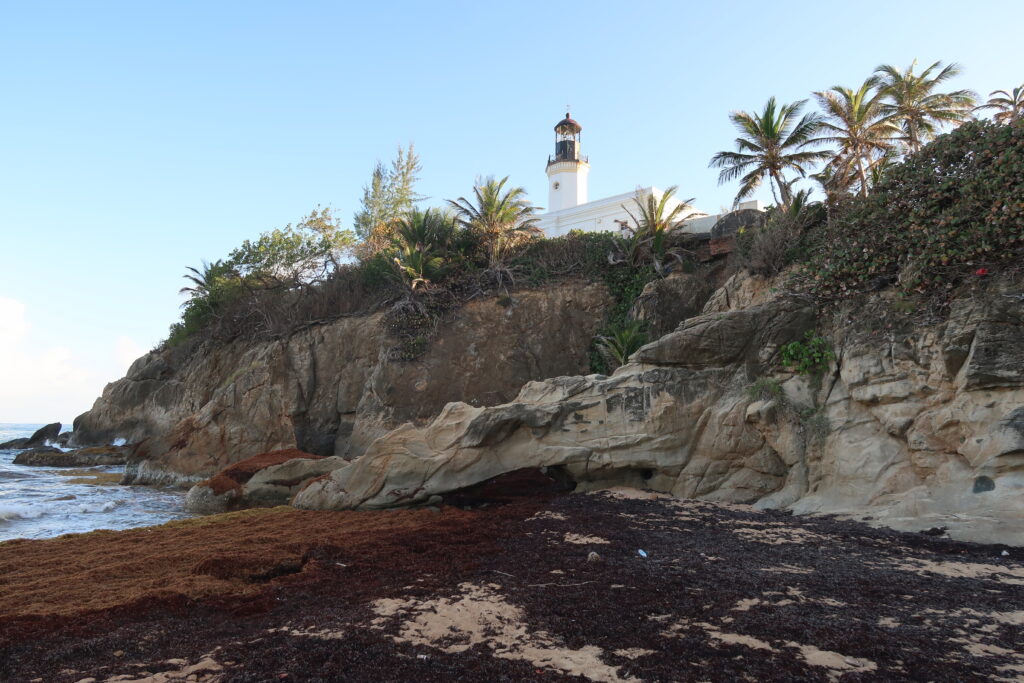
One could sink the seaweed before it reaches the beach, said microbial oceanographer Ajit Subramaniam from the Lamont-Doherty Earth Observatory at Columbia University.
On the basis of data from a 2021 publication, Subramaniam estimated that 100,000 metric tons of carbon dioxide could be captured per year using naturally occurring seaweed. And he’s okay with that: “I personally don’t buy the gigaton-or-bust argument.”
Sequestering many small pools of carbon, instead of one big pool, reduces the risk of widespread unintended consequences and circumvents the logistical issues around setting up seaweed farms, he argued.
“We should stop thinking of the sea as like a big, dark hole.”
At least two companies are working on sinking natural blooms of seaweed. In the United Kingdom, Seaweed Generation is designing an aquatic robot that could skim Sargassum off the surface of the water, then submerge it to 150 meters below, where the pressure is high enough to pop the gas sacks that keep it afloat. Meanwhile, in the Dominican Republic, a company called SOS Carbon wants to contract people with small boats to collect seaweed in nets, then ferry it to a larger boat, where it will be pumped deep enough to sink naturally.
Not everyone is comfortable with the idea of submerging Sargassum, whether it’s wild or cultivated. “We should stop thinking of the sea as like a big, dark hole,” Chávez said. “The long-term effects [of submerging seaweed] are really unknown.”
When he considers seaweed strategies in general, Long said he sees a need to balance uncertainty against the urgent need to halt climate change. “I strongly believe we should have a somewhat permissive stance on uncertainty early on,” he said. On the other hand, scientists need a framework for reducing that uncertainty over time to make sure the carbon market is solving the problem it’s setting out to address.
“We need market-quality systems now,” he said. “But those systems cannot be enshrined as static, fixed entities. They need to be enshrined as procedures that are expected to evolve and grow.”
—Saima May Sidik (@saimamaysidik), Science Writer

